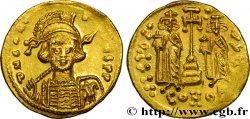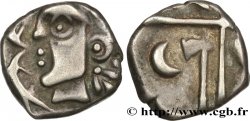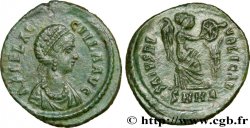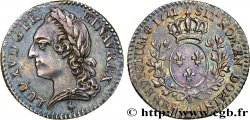v50_0028 - CLODIUS ALBINUS Denier
MONNAIES 50 (2011)
Startpreis : 950.00 €
Schätzung : 2 000.00 €
Erzielter Preis : 950.00 €
Anzahl der Gebote : 1
Höchstgebot : 980.00 €
Startpreis : 950.00 €
Schätzung : 2 000.00 €
Erzielter Preis : 950.00 €
Anzahl der Gebote : 1
Höchstgebot : 980.00 €
Type : Denier
Datum: 196-197
Name der Münzstätte / Stadt : Gaule, Lyon
Metall : Silber
Der Feingehalt beträgt : 500 ‰
Durchmesser : 17,5 mm
Stempelstellung : 12 h.
Gewicht : 3,55 g.
Seltenheitsgrad : INÉDIT
Emission: 2e
Kommentare zum Erhaltungszustand:
Exemplaire de qualité exceptionnelle pour ce monnayage souvent mal frappé et mal conservé sur un petit flan épais. Portrait de haut relief, bien venu à la frappe, finement détaillé. Revers de toute beauté, parfaitement lisible et identifiable. Très jolie patine de médaillier avec des reflets dorés. Conserve une partie de son brillant de frappe et de son coupant d’origine
Vorderseite
Titulatur der Vorderseite IMP CAES D CLO - SEP ALB AV-G.
Beschreibung Vorderseite Buste lauré de Clodius Albinus à droite drapé sur l’épaule (O*2).
Übersetzung der Vorderseite “Imperator Cæsar Decimus Clodius Septimius Albinus Augustus”, (L’empereur césar Décimus Clodius Albinus auguste).
Rückseite
Titulatur der Rückseite MARTI - AVG COS II.
Beschreibung Rückseite Mars casqué, nu debout à droite, tenant de la main droite une longue javeline renversée et appuyé de la main gauche sur son bouclier.
Übersetzung der Rückseite “Marti Augusti Consul iterum”, (Au Mars de l’auguste consul pour la deuxième fois).
Kommentare
Même coin de revers que l’exemplaire du Kunsthistorisches Museum de Vienne (B. 31/1, pl. LVII, R/ 66). Mais notre exemplaire avec un buste lauré à droite avec petit pan de paludamentum visible de chaque côté du cou au droit est complètement inédit et non répertorié et manque à tous les ouvrages consultés. Cependant, le coin de droit est très proche de l’exemplaire du musée de Saint-Omer (B. 44/1, pl. LVIII, A/ 93), mais semble néanmoins nouveau. De plus, notre exemplaire permet de confirmer la lecture du revers qui était incomplète avec MARTI - AVG COS II, la légende MARTI étant légèrement tréflée, mais indiscutable alors que la lecture de l’exemplaire du Musée de Vienne était incomplète dû au décentrage qui ne permettait de ne voir que le M de M(arti). Pour le type de revers, c’est le deuxième exemplaire recensé. En revanche pour le droit, nous sommes en présence d’un nouveau numéro qui devrait s’intégrer entre le numéro 30 et 31 dans le Supplément III du Bastien sous le numéro 30(alpha). Ce type est absent des collections publiques.
Same reverse die as the example from the Kunsthistorisches Museum in Vienna (B. 31/1, pl. LVII, R/ 66). But our example with a laureate bust on the right with a small panel of paludamentum visible on each side of the neck on the right is completely unpublished and unlisted and is missing from all the works consulted. However, the obverse die is very close to the example from the Saint-Omer museum (B. 44/1, pl. LVIII, A/ 93), but nevertheless seems new. In addition, our example confirms the reading of the reverse which was incomplete with MARTI - AVG COS II, the legend MARTI being slightly trefoiled, but indisputable while the reading of the example from the Vienna Museum was incomplete due to the off-centering which only allowed one to see the M of M(arti). For the type of reverse, this is the second example listed. On the other hand, for the law, we are in the presence of a new number which should be integrated between number 30 and 31 in Supplement III of Bastien under number 30(alpha). This type is absent from public collections
Same reverse die as the example from the Kunsthistorisches Museum in Vienna (B. 31/1, pl. LVII, R/ 66). But our example with a laureate bust on the right with a small panel of paludamentum visible on each side of the neck on the right is completely unpublished and unlisted and is missing from all the works consulted. However, the obverse die is very close to the example from the Saint-Omer museum (B. 44/1, pl. LVIII, A/ 93), but nevertheless seems new. In addition, our example confirms the reading of the reverse which was incomplete with MARTI - AVG COS II, the legend MARTI being slightly trefoiled, but indisputable while the reading of the example from the Vienna Museum was incomplete due to the off-centering which only allowed one to see the M of M(arti). For the type of reverse, this is the second example listed. On the other hand, for the law, we are in the presence of a new number which should be integrated between number 30 and 31 in Supplement III of Bastien under number 30(alpha). This type is absent from public collections








 Berichten über einen Fehler
Berichten über einen Fehler Die Seite drucken
Die Seite drucken Teilen meiner Auswahl
Teilen meiner Auswahl Stellen Sie eine Frage
Stellen Sie eine Frage Einlieferung/Verkauf
Einlieferung/Verkauf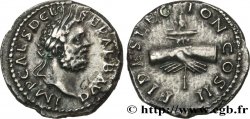
 Details
Details